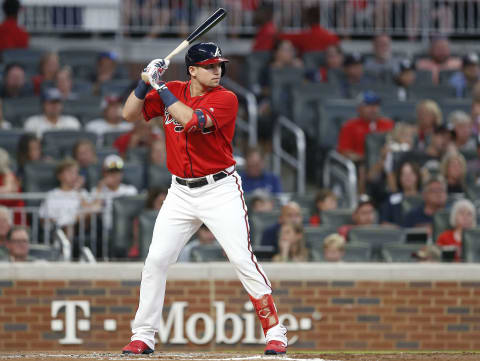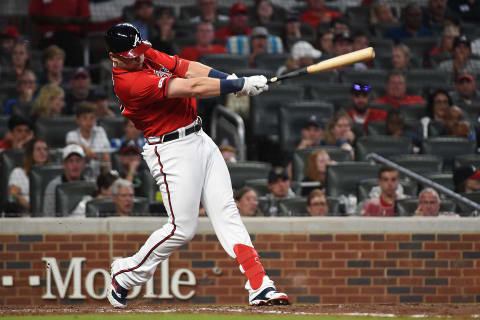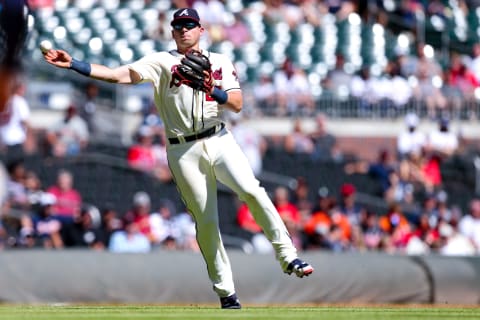Can Austin Riley Bounce Back for Atlanta Braves in 2020?


Austin Riley showed a month of brilliance last May for the Atlanta Braves before Major League pitchers exposed his weaknesses. Can he rebound during this shortened season?
Riley’s meteoric rise for the Atlanta Braves early in the 2019 campaign culminated in a turbulent tumble of massive proportions.
The rookie slugger, who was drafted by the Braves in 2015 and ascended through the minor league ranks with his powerful right-hand bat, transitioned from a May sensation to a young hitter marred in a prolific, season-long slump.
Riley decimated minor league pitching in 2019 during his short stint at Triple-A Gwinnett (.391 average, 13 home runs, and an astounding 1.518 OPS). It was a reflection of Riley’s minor league track record, where, in 1,788 at-bats, he hit .283/.348 with 86 home runs.
After, rather inconceivably, homering nine times in his first 18 games in the Majors, pitchers did what they do best.
They made adjustments. They exposed his weaknesses. The figured him out.
Riley suffered a similar fate most young hitters fall victim to – the thrill of burgeoning success followed by a dreadful streak where they fail to adapt and experience the pitfalls of enhanced pitch sequences, thorough scouting reports, and the intuition Major League pitchers possess when facing the greatest hitters on the planet.
For all of Riley’s majestic swings that first month or so of his Major League career, he was, to be rather frank, miserable the rest of the way.
His rising star simply descended back down to reality.
But all is not lost. And, let’s be honest, hitting a baseball at the highest level is no easy feat. If it were, I wouldn’t be crafting this article right now.
Rookie hitters – especially those prone to the power game – unfortunately fall into the trap of relying on the strengths that catapulted them through the minors.
Their talents ebb and flow. They try to find their footing. Many of them fail. Some make adjustments. Others flounder.
For all it’s worth, Riley has proven – albeit through just a short, burst of brilliance – to have the skill set needed to hit Major League pitching.
But it comes down to making modifications and constantly striving to improve on pitch recognition.
We all know the 2020 season is an anomaly. Five months ago, we were wondering if Riley would be the starting third baseman for the Braves or if he would be refining his swing down on the farm.
Alex Anthopoulous and Company don’t have that luxury in their back pocket at this point.
The entire baseball world has been flipped upside down. Now we’re debating whether Riley will play a bit of first base, share time with Johan Camargo at third, be plugged into the DH spot, or, perhaps unrealistically, give the Braves a lift in left field.
Much like Riley’s prospects for 2020, this baseball season is brimming with question marks. Nothing is set in stone.
So, let’s dig in a bit deeper into what we can expect from Riley in this shortened season by first analyzing his 2019 performance.

If there’s one item that leaps off the stat page from last year, it’s Riley’s absurd strikeout rate with the Atlanta Braves(tip of the cap to FanGraphs for providing stats included within this article).
In just 274 at-bats, he struck out an eye-popping 108 times. That’s good for a strikeout rate of 39.4 percent, which won’t provide a player with much praise.
But before roasting Riley for his faults, let’s take a second to reflect on his remarkable ascent.
Riley, who homered in his second big league at-bat on May 15, put together an unbelievable slash-line of .356/.397/.746 with seven home runs and 20 RBI in just 15 games. For his efforts, he was named the National League Rookie of the Month in May. In his first 183 Major League at bats, he hit .262 with 16 home runs.
But following his tremendous month of May, Riley took a precipitous plunge.
The long ball was never in question.
The ability to hit a slider and lay off of off-speed pitches out of the zone, however, was.
Riley clearly tried to adjust. But by concentrating on the off-speed pitches, he ended up missing fastballs.
In early August, he suffered a right knee sprain while working out, which was later revealed to be a partial tear in his lateral collateral ligament. He finished the season batting .239 with 18 home runs and 49 RBI.
In the second half of the season, he hit just .161, which included two home runs in 31 games.
To gain a better understand of his downward trajectory, let’s take a look at the splits.
May (59 at-bats): .356, 7 home runs, 20 RBI, 21 strikeouts
June (106 at-bats): .226, 7 home runs, 17 RBI, 37 strikeouts
July (64 at-bats): .156, 2 home runs, 7 RBI, 30 strikeouts
Aug/Sept/Oct (45 at-bats): .155, 2 home runs, 5 RBI, 18 strikeouts
Riley, now 23, is still widely-regarded as one of the top young bats in the big leagues, purely from a power perspective.
But in 2020, questions abound. Where will he play? Can he maintain consistency?
There’s no opportunity to figure things out down on the farm. He’ll only have 60 regular season games to prove it, and, like everyone else facing the arms housed in the National League East and American League East, there isn’t exactly a lull in talent.
So, let’s find out what we can expect.

Despite everything else happening around the world, there was a glimmer of hope for Atlanta Braves fans in March.
During Spring Training 1.0, Riley was refreshed, slashing .357/.438/.643 with a 1.080 OPS. Sure, it was a small sample size (28 at-bats), but the strikeouts dramatically declined (he only stuck out five times).
As previously mentioned, Riley’s strikeout rate was unprecedented in 2019. He went from a 20.1 percent strikeout rate in 44 minor league games in 2019, to the aforementioned 36.4 percent in 80 Major League games.
But there’s a lot of positives to take away from his spring performance and his spray charts from last season. When Riley and his colossal frame made contact, as opposed to most power hitters, he wasn’t strictly pulling the ball to left field. He was, in fact, hitting the ball solidly, pulling the ball 36.3 percent of the time, connecting to center 40.5 percent of the time, and pushing it to the opposite field at a rate of 28.9 percent.
He also proved last season that, like most professional hitters, he’s a stronger hitter when he works the count into his favor.
And that will be key for him this year. If he can maintain consistency in recognizing off-speed pitches, capitalize on his bread-and-butter by connecting with fastballs, and maintain selectivity while working the count, the opportunity to showcase his natural power will shine through.
But, of course, that’s easier said than done.
Riley is a bright young kid. He’s shown that he is committed to making the changes needed to succeed at this level.
The path he takes, though, in this shortened season could predict his future. Does he become the next Troy Glaus or say Mark Reynolds or could we be looking at Kevin Cron or Mike Hessman 2.0?
Yes, I realize that’s dramatic. He’s only in his second season. But it’s an interesting thought for a player on the precipice of either potential stardom or unfulfilled promise.

The other glaring question for the Atlanta Braves is where does Riley play this year?
When manning his natural position, third base, Riley has proven to be a solid glove (he committed no errors at third last season in a short sample size). When he owns the position, and isn’t simply plugging a hole or a need, he has the potential to be an above-average third baseman, if not Gold Glove caliber fielder.
But the Braves have plenty of needs this season elsewhere.
And luckily for Riley, he gives the Braves options.
While many would still give Camargo the upper hand to be the starting third baseman, we’ll definitely see Riley there for spells.
With the questions surrounding Freddie Freeman’s health to start the regular season (testing positive for COVID-19 earlier this month), as well as Nick Markakis’ opt-out for 2020, there will not be a shortage of opportunities to plug Riley into the lineup.
In 2019, Riley played in six games at first base (committing one error). He’ll compete, for as long as Freeman’s out, with Adam Duvall, Camargo, and potentially Yonder Alonso (should he be included in the Opening Day roster) for playing time there.
As for left field, Riley played in 58 games in 2019, and, as we all know, he had his troubles covering ground and routing fly balls in an unnatural position. Depending on the health of the Braves primary outfielders (Ronald Acuna Jr., Ender Inciarte, and Marcell Ozuna), as well as how Duvall is utilized, it’s unlikely Riley will spend much time in left.
Riley’s greatest opportunity for at-bats comes with the National League’s institution of the DH. No matter how you frame it, plugging a powerful bat like Riley’s into the fifth or sixth spot of the lineup and allowing him to focus purely on hitting not only ensures there’s a potential run producer in the back-half of the lineup, but also allows Riley to get the at-bats needed to continue his progression.
In 2020, we can expect Riley to fill the gaps, especially as DH. From a statistical standpoint, 10 homers and 20-25 RBI isn’t out of the realm of possibility if he gets on a similar early-season tear, sees the ball well, and makes the adjustments needed.
But there are a lot of what-ifs.
What if he struggles from the onset? What if he falls back on last year’s follies? What if he’s outperformed by Camargo, Duvall, etc.? And, of course, what if the season is cut short?
Is Max Fried ready to fly in 2020?. dark. Next
Austin Riley has a lot to prove in a short season. What are your expectations for him in 2020? Let us know in the comments.